Mausoleum of the Yellow Emperor: A Historic Gem in China’s Scenic Landscape
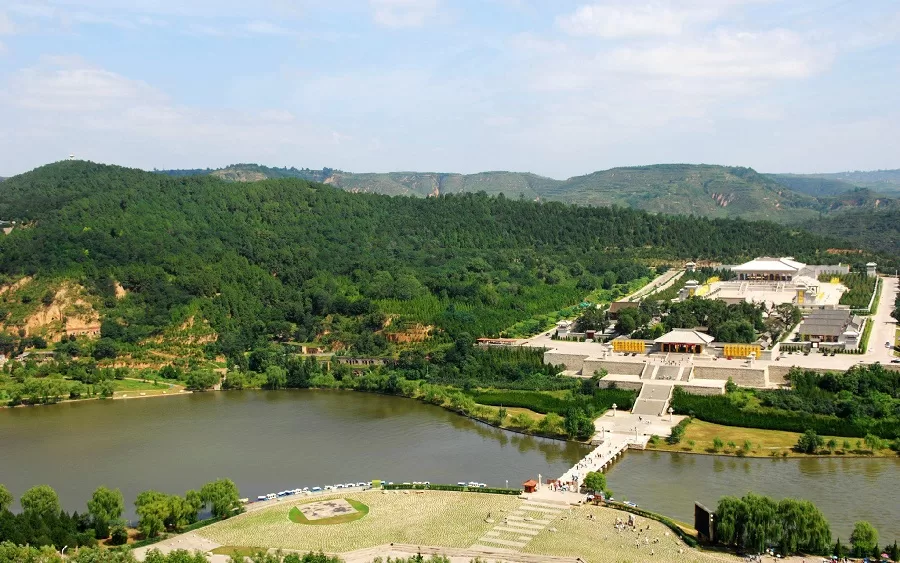
An Essential Guide to Visiting Mausoleum Of The Yellow Emperor Scenic Area
In This Guide
- An Essential Guide to Visiting Mausoleum Of The Yellow Emperor Scenic Area
- The Rich History and Legends of Mausoleum Of The Yellow Emperor Scenic Area
- Main Highlights: What You Absolutely Can’t Miss
- Planning Your Visit: A Practical Guide
- Tickets: Prices, Booking, and Tips
- How to Get There: A Complete Transportation Guide
- Local Cuisine and Accommodation Nearby
- Frequently Asked Questions
- Final Thoughts on Your Trip
Discover the Legacy of the Yellow Emperor
As you embark on your journey through the heart of China’s historical landscape, the Mausoleum of the Yellow Emperor Scenic Area beckons with its rich tapestry of legend and culture. Revered as the birthplace of Chinese civilization, this site honors the Yellow Emperor, Huangdi (黄帝), who is not just a mythical figure but a symbol of the Chinese identity, celebrated for his contributions to agriculture, medicine, and governance.
Nestled in the picturesque surroundings of Lingbao in Shaanxi Province, this scenic area offers more than just a mausoleum; it provides a profound glimpse into China’s ancient past. Here, towering cypress trees whisper tales of the past, with one believed to be over 5,000 years old, allegedly planted by the Yellow Emperor himself. The grandeur of the mausoleum, reminiscent of classical architectural influences, stands in stark contrast to traditional Chinese design, creating a unique atmosphere that invites exploration and reflection.
Whether you are a history buff, a cultural enthusiast, or simply a curious traveler, the Mausoleum of the Yellow Emperor Scenic Area promises an enriching experience. From beautiful landscapes to solemn pavilions adorned with poetry, each corner of this site reveals stories that have shaped the very essence of Chinese civilization. Prepare to be captivated by the serenity and significance of this historic landmark as you delve into the legacy of one of China’s most iconic figures.

Mausoleum_Of_The_Yellow_Emperor_Scenic_Area.
The Rich History and Legends of Mausoleum Of The Yellow Emperor Scenic Area
The Mausoleum of the Yellow Emperor, known as Huangdi Ling (黄帝陵), stands as a monumental tribute to one of the most revered figures in Chinese history—the Yellow Emperor, or Huangdi. This vast scenic area not only honors the legacy of Huangdi but also encapsulates the rich tapestry of Chinese legends and cultural heritage.
A Legendary Figure
Huangdi, believed to have reigned over 5,000 years ago, is often regarded as the initiator of Chinese civilization. According to legends, he was not only a great leader but also a skilled warrior and a wise statesman. His contributions to Chinese culture include the invention of various tools, advancements in medicine, and the establishment of governmental structures. His reign is often associated with the unification of tribes and the beginning of a cohesive Chinese identity.
The Mausoleum: A Testament to Time
The mausoleum itself is an architectural marvel, reflecting a blend of ancient and modern styles. Built atop a hill, it offers breathtaking views of the surrounding landscape, emphasizing the connection between nature and history. The site features impressive cypress trees, with one specimen purportedly planted by Huangdi himself over 5,000 years ago. These trees are not only a testament to the age and reverence of the site but also embody the enduring legacy of the Yellow Emperor.

Mausoleum_Of_The_Yellow_Emperor_Scenic_Area.
Architectural Inspirations
The design of the mausoleum draws interesting comparisons to iconic structures such as the Pantheon in Rome and the austere buildings of Berlin. This unique architectural style, characterized by its minimalism and grandeur, resonates deeply with visitors. The centerpiece is a striking stone stele adorned with a representation of Huangdi, symbolizing his enduring presence and influence in Chinese culture.
Cultural Significance
The mausoleum serves as a focal point for the modern quest for “roots” in Chinese society. It embodies a deep respect for ancestry and heritage, where visitors can connect with the past through rituals and offerings. One can experience the cultural significance of this site firsthand by participating in traditional practices, such as burning incense to pray for the prosperity of future generations.
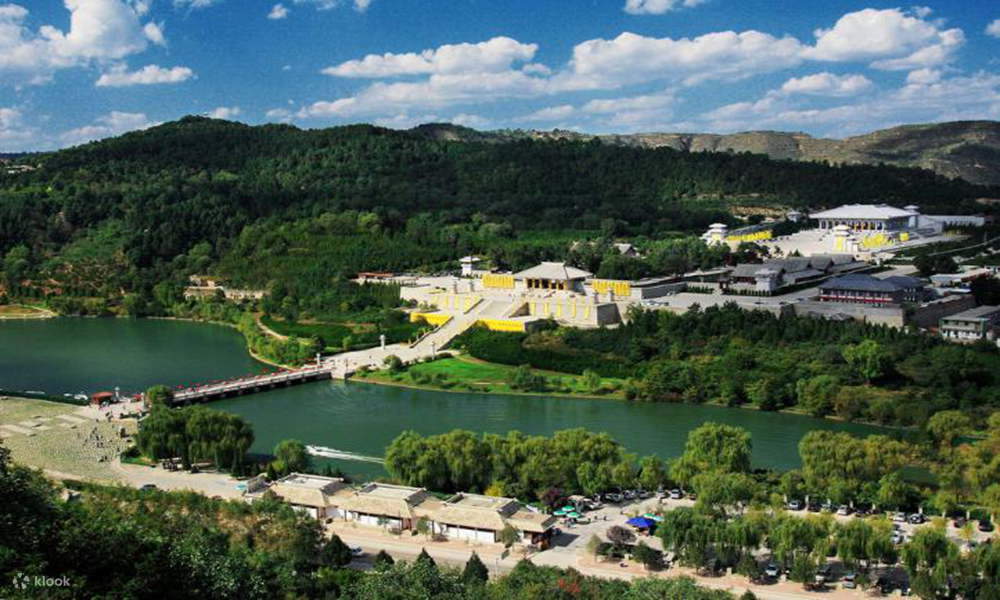
Mausoleum_Of_The_Yellow_Emperor_Scenic_Area.
Legends of the Yellow Emperor
The legends surrounding the Yellow Emperor are both rich and varied. One popular story recounts how he battled the fierce tribal leader Chi You to secure unity among the tribes. This epic confrontation is often cited as a foundational myth for Chinese identity, symbolizing the struggle for unity and peace.
Moreover, Huangdi is credited with numerous inventions and innovations, including the development of herbal medicine and the establishment of the Chinese calendar. These contributions have left an indelible mark on Chinese civilization, further solidifying his status as a cultural hero.

Mausoleum_Of_The_Yellow_Emperor_Scenic_Area.
A Place for Reflection
Visitors to the Mausoleum of the Yellow Emperor Scenic Area can explore not only the mausoleum but also the expansive grounds that include beautiful lakes and gardens. The serene environment provides a perfect backdrop for contemplation, allowing travelers to reflect on the profound historical narratives that have shaped Chinese culture.
In summary, the Mausoleum of the Yellow Emperor is far more than a mere historical site; it is a vibrant celebration of Chinese heritage, a place where legends come alive, and a testament to the enduring spirit of a civilization that has thrived for millennia. Whether you are drawn by history, architecture, or culture, this scenic area promises an enriching experience that resonates deep within the heart of China’s past.
Main Highlights: What You Absolutely Can’t Miss
Discover the Treasures of the Mausoleum of the Yellow Emperor Scenic Area
A visit to the Mausoleum of the Yellow Emperor Scenic Area (黄帝陵景区) promises a unique glimpse into the depths of Chinese history and culture. Revered as the burial site of the legendary Yellow Emperor, Huangdi (黄帝), this site is not only a tribute to a pivotal figure in Chinese civilization but also a stunning example of harmonious architecture nestled within the natural beauty of the surrounding hills. Here are the main highlights that you absolutely cannot miss.

Mausoleum_Of_The_Yellow_Emperor_Scenic_Area.
1. The Majestic Cypress Trees
As you enter the scenic area, you are greeted by towering cypress trees that stand as sentinels to history. One tree, over 5,000 years old, is said to have been planted by the Yellow Emperor himself. Another, equally impressive at 3,500 years old, has a fascinating history, having once served as the place to hang the armor of generals before they marched into battle. These ancient trees symbolize wisdom and endurance, setting the tone for your exploration.
2. The Grand Mausoleum
The mausoleum itself is a modern architectural marvel, drawing inspiration from the grand designs of the Roman Pantheon and the austere buildings of Berlin. Its minimalistic yet imposing structure is designed to evoke a sense of reverence and awe. Inside, a 6-meter stone stele depicts the Yellow Emperor, with inscriptions detailing his significance to Chinese history. The expansive courtyard surrounding the mausoleum rivals the grandeur of Beijing’s Forbidden City, offering an open space that enhances the feeling of being in a historical realm, unbounded by walls.
3. The Serene Courtyard and Pavilions
The courtyard is adorned with huge metal urns and lined with yellow flags, creating a striking visual that is reminiscent of ancient cinematic landscapes. Here, you can also find pavilions that house poetry and inscriptions from both the Yellow Emperor and Chairman Mao, reflecting the intertwining of history and modern narratives in contemporary China.
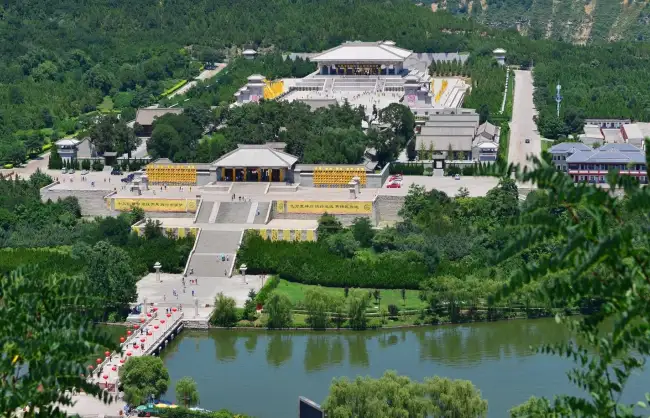
Mausoleum_Of_The_Yellow_Emperor_Scenic_Area.
4. Engage in Tradition: Incense Burning
A unique cultural experience awaits you at one of the pavilions where visitors can purchase incense for a small fee of 5 RMB. This ritual allows you to express gratitude to the Yellow Emperor and pray for the prosperity of future generations. However, be mindful of vendors eager to upsell; it’s wise to be cautious about any unsolicited services offered.
5. The Scenic Surroundings
Beyond the mausoleum, the scenic area offers expansive grounds that include a picturesque lake, perfect for a leisurely stroll or a moment of reflection amidst nature. The tranquil surroundings enhance the spiritual atmosphere of the site, making it a place where history and nature coexist beautifully.
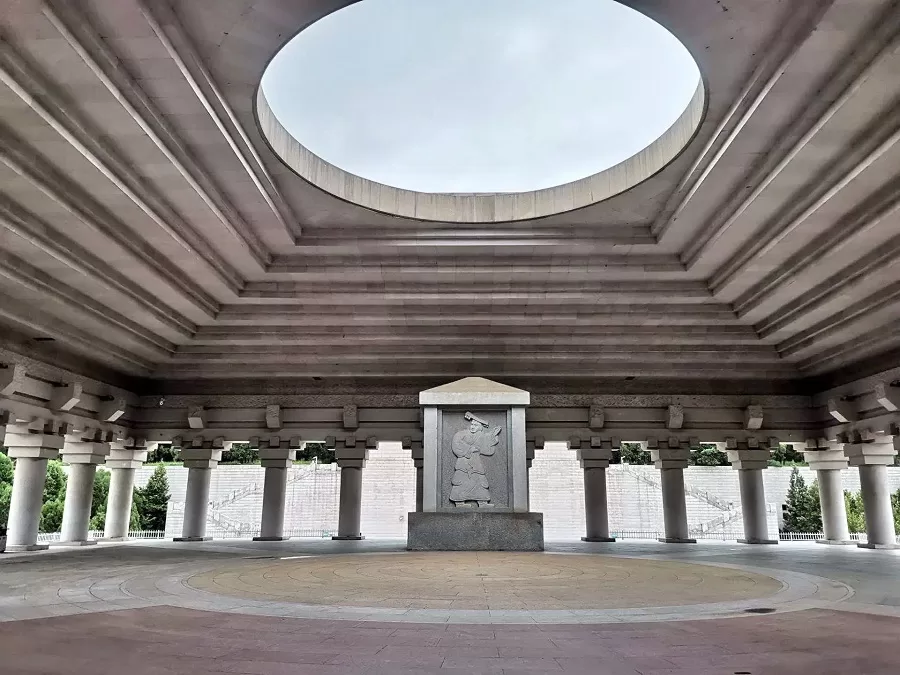
Mausoleum_Of_The_Yellow_Emperor_Scenic_Area.
6. The Journey to the Tomb
To reach the tomb of the Yellow Emperor, visitors can take an electric car (for an additional fee) to the base of the hill. The final ascent to the tomb requires a 15-minute walk, allowing you to immerse yourself in the serene environment and perhaps encounter local vendors along the way. While the tomb itself is relatively simple, its historical significance is profound, inviting contemplation of the legacy of the Yellow Emperor.
7. Plan Your Visit
To fully appreciate this historical site, allocate a few hours for exploration. The Mausoleum of the Yellow Emperor Scenic Area is generally open from 7:30 AM to 6:30 PM, making it accessible for both early risers and afternoon explorers. The entrance fee is approximately 90 RMB, a modest price for the wealth of history and culture you will experience.
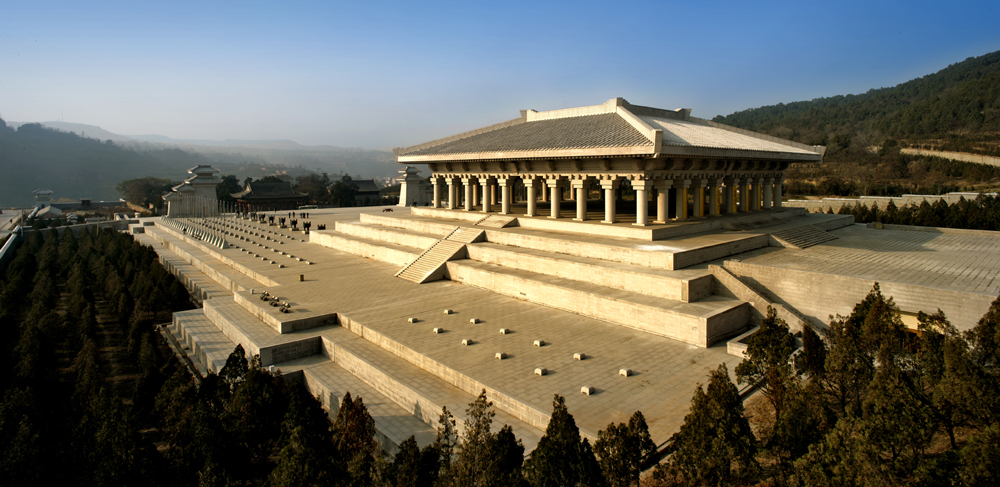
Mausoleum_Of_The_Yellow_Emperor_Scenic_Area.
Conclusion
The Mausoleum of the Yellow Emperor Scenic Area is a remarkable destination that weaves together the threads of ancient history, cultural reverence, and natural beauty. Whether you are a history buff, a cultural enthusiast, or simply seeking a peaceful retreat, this site offers a captivating journey into the heart of Chinese heritage that you won’t want to miss.
Planning Your Visit: A Practical Guide
Preparing for Your Journey to the Mausoleum of the Yellow Emperor
Nestled in the serene hills of Lingbao, the Mausoleum of the Yellow Emperor (黄帝陵) is not just a historical site; it represents a vital piece of China’s cultural heritage. This guide will help you navigate your visit, ensuring you make the most of this significant landmark steeped in ancient lore.
Getting There
Location:
The Mausoleum is located in Yangping Town, Lingbao, Henan Province. It is accessible by car or public transportation from nearby cities, including Yan’an and the Kukou Waterfall, making it a convenient stop on your travels.
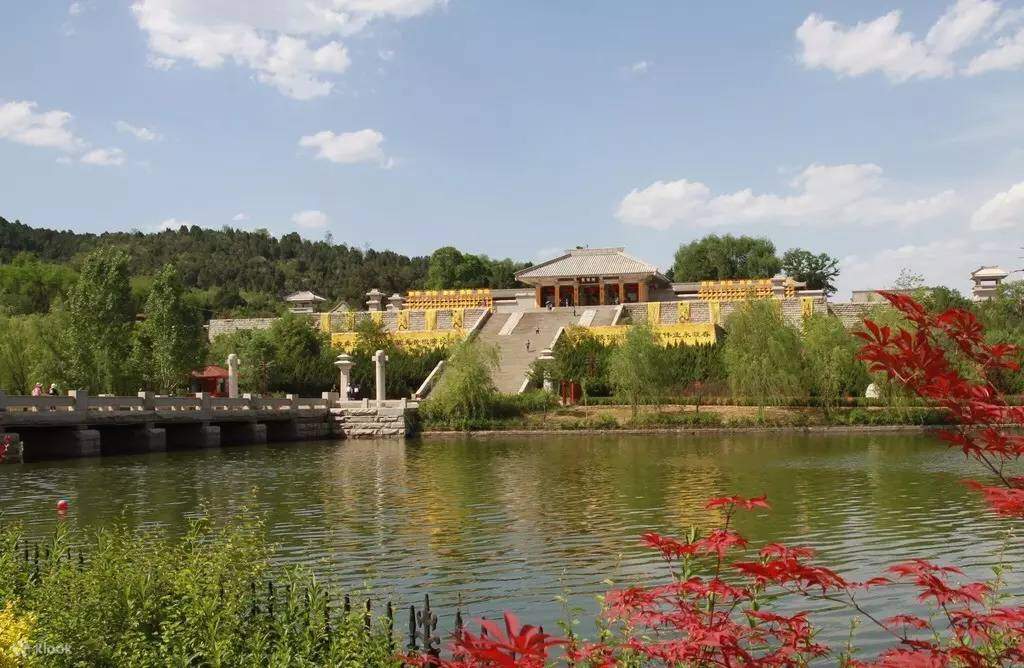
Mausoleum_Of_The_Yellow_Emperor_Scenic_Area.
Entry Fee:
The entrance fee is approximately 90 RMB. Be prepared to pay this fee in cash, as some vendors may not accept cards.
Opening Hours
The site operates daily from 7:30 AM to 6:30 PM. It’s advisable to arrive early to enjoy a more tranquil experience, especially during weekends or holidays when the site can become crowded.
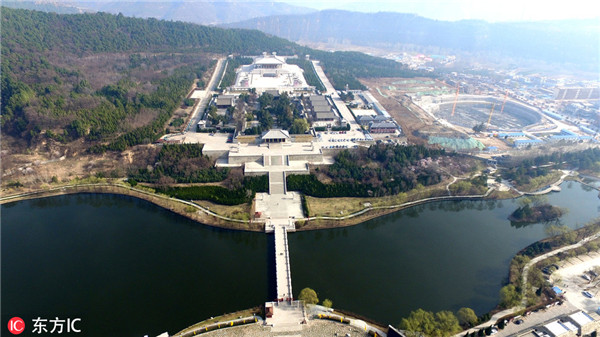
Mausoleum_Of_The_Yellow_Emperor_Scenic_Area.
What to Expect
Key Attractions
-
Ancient Cypress Trees
Marvel at two of the oldest cypress trees in China—one estimated to be 5,000 years old and another around 3,500 years old. These trees are not only breathtaking but also steeped in legend, as one was believed to be planted by the Yellow Emperor himself. -
The Mausoleum Structure
The mausoleum features a minimalist design reminiscent of the Pantheon in Rome, with a grand oracle in the ceiling that creates a profound atmosphere. A striking 6-meter stone stele adorned with the Emperor’s image stands at its center, drawing visitors into the rich historical narrative. -
Expansive Courtyard
The courtyard rivals the grandeur of Beijing’s Forbidden City, set against a backdrop of undulating hills. Its openness, adorned with yellow flags and metal urns, evokes a sense of stepping back in time. -
Pavilions and Poetry
Explore pavilions that showcase poetry from the Yellow Emperor and Mao Zedong, integrating history with the modern narrative of Chinese cultural identity. -
Prayer Pavilion
For a nominal fee of 5 RMB, you can burn incense as a gesture of respect and gratitude to the Yellow Emperor. However, be cautious of vendors who may attempt to sell you overpriced items for your prayers.
Climbing to the Tomb
To reach the tomb itself, you’ll need to take an electric car (separate fee) to the base. The final ascent involves a 15-minute walk uphill, where you may encounter local vendors selling souvenirs. If you’re not interested, it’s perfectly acceptable to ignore their offers.
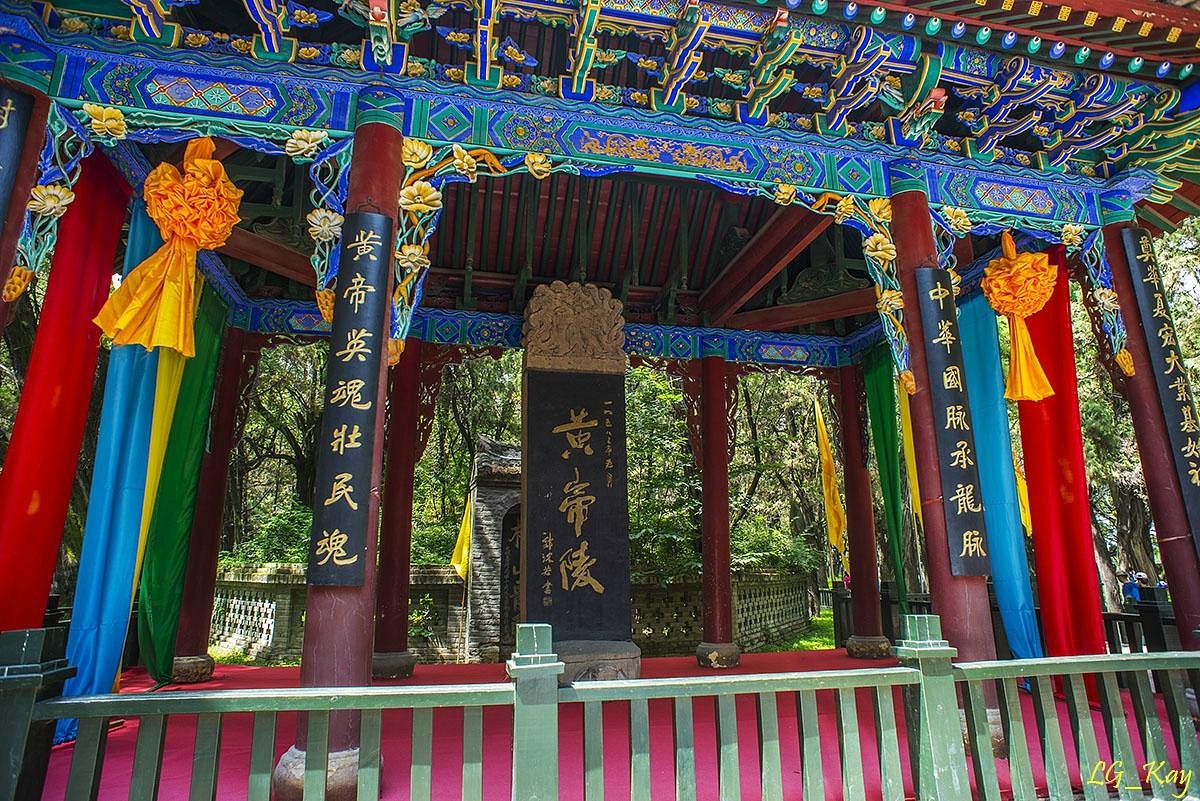
Mausoleum_Of_The_Yellow_Emperor_Scenic_Area.
Tips for a Smooth Visit
-
Time Your Visit: Aim for a few hours to fully appreciate the site, including time for the walk to the tomb and exploring the grounds.
-
Stay Aware: Be cautious of vendors pushing incense and trinkets at inflated prices. Politely decline if you’re not interested.
-
Photography: Bring your camera! The scenic surroundings and architectural beauty make for stunning photographs.
-
Respect the Site: As a place of historical importance, maintain decorum, especially in prayer areas and near the mausoleum.
Nearby Attractions
Should you wish to extend your visit, consider these nearby sites:
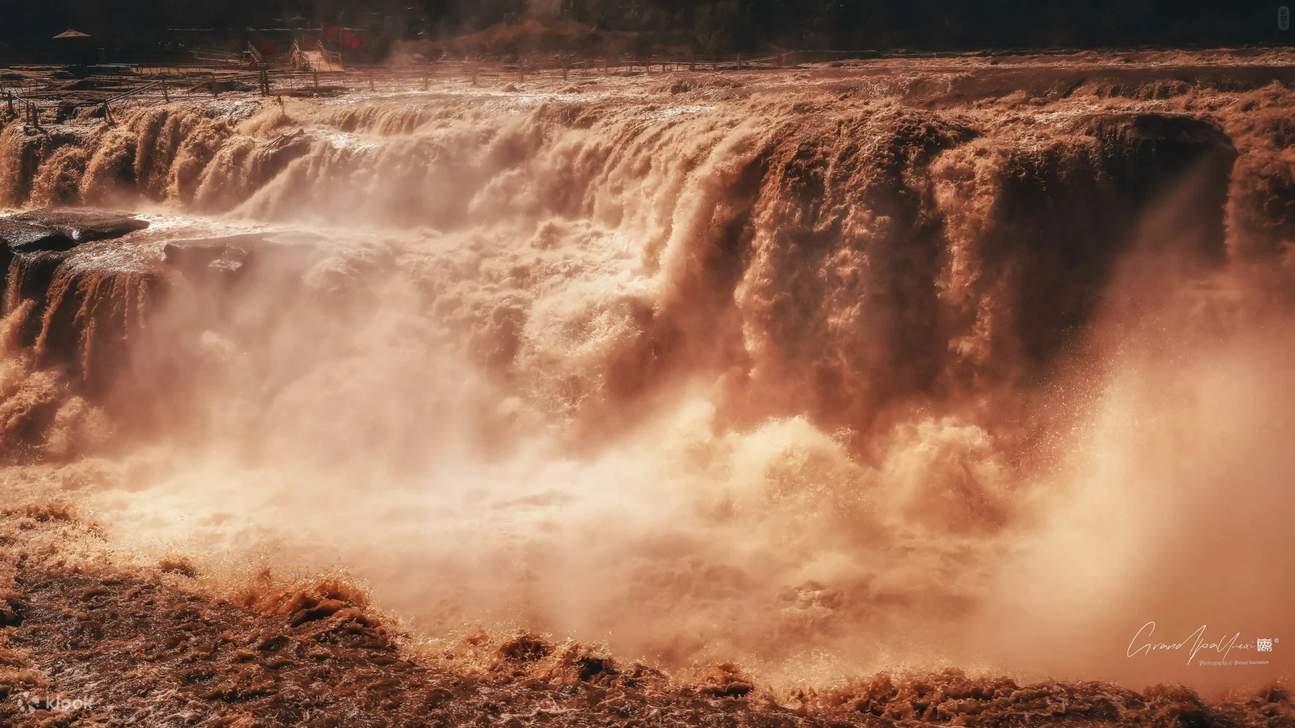
Mausoleum_Of_The_Yellow_Emperor_Scenic_Area.
-
Kukou Waterfall: A natural wonder that offers a refreshing contrast to the historical significance of the mausoleum.
-
Beiyangping Ruins: Explore ancient ruins that add context to the region’s rich history.
Conclusion
The Mausoleum of the Yellow Emperor is more than just a tourist destination; it is a pilgrimage site that echoes the roots of Chinese civilization. By planning your visit thoughtfully, you can immerse yourself in the profound history and culture that this remarkable site embodies. Enjoy your journey!
Tickets: Prices, Booking, and Tips
Visiting the Mausoleum of the Yellow Emperor: Essential Ticket Information
When planning your visit to the Mausoleum of the Yellow Emperor Scenic Area (黄帝陵景区), it is important to be well-informed about ticket prices, booking options, and some practical tips to enhance your experience. Located in Lingbao, this historical site not only honors one of China’s legendary figures but also offers travelers a glimpse into the rich cultural heritage of the region.
Ticket Prices
- General Admission: The entry fee is 90 RMB (approximately $14 USD). This ticket grants you access to the main attractions within the scenic area, including the mausoleum itself, the surrounding courtyards, and the ancient cypress trees that stand as living testaments to the site’s historical significance.
- Incense Purchase: If you wish to partake in the traditional practice of burning incense, a small fee of 5 RMB is required for the incense itself.
- Transportation Fee: An electric car is available to transport visitors to the entrance of the tomb, which incurs a separate fee. This service is particularly useful for those who may find the walk to the tomb challenging.
Booking Information
- On-Site Purchase: Tickets can be purchased directly at the entrance of the scenic area. It is advisable to arrive early, especially during peak tourist seasons, to avoid long lines.
- Advance Booking: While advance online booking may not be widely available for this site, consider contacting local travel agencies or your hotel in Lingbao for assistance in securing tickets or guided tours.
Tips for a Smooth Visit
-
Timing Your Visit: The mausoleum is open daily from 7:30 AM to 6:30 PM. Arriving early will allow you to explore the site with fewer crowds and enjoy the serene atmosphere.
-
Plan for Vendors: As you navigate the grounds, be prepared for vendors selling various items, including incense and souvenirs. While some purchases are culturally significant, it’s wise to set a budget and remain cautious of high-pressure sales tactics.
-
Be Aware of Scams: While burning incense is a meaningful activity, be cautious of individuals offering to pray for you in exchange for a significant fee. Politely decline any unsolicited offers.
-
Explore the Grounds: Don’t rush your visit! Take time to appreciate the stunning ancient cypress trees, particularly the impressive 5000-year-old tree believed to have been planted by the Yellow Emperor himself.
-
Enjoy the Scenic Beauty: The area surrounding the mausoleum features a picturesque lake and expansive grounds, perfect for leisurely walks and photography.
-
Respect Cultural Practices: Observe local customs and practices during your visit, particularly in the areas designated for prayer and incense burning.
By understanding the ticketing process and preparing for your visit, you can maximize your experience at the Mausoleum of the Yellow Emperor, immersing yourself in the rich tapestry of Chinese history and culture.
How to Get There: A Complete Transportation Guide
Navigating Your Journey to the Mausoleum of the Yellow Emperor Scenic Area
Visiting the Mausoleum of the Yellow Emperor Scenic Area (黄帝陵景区) is a remarkable way to immerse yourself in China’s rich historical tapestry. Located in Lingbao, Henan Province, this site not only pays homage to one of China’s legendary figures but also offers breathtaking natural surroundings. Here’s your complete guide to getting there seamlessly.
1. Arrival by Air
The nearest major airport is Zhengzhou Xinzheng International Airport (CGO), approximately 200 kilometers from Lingbao. This airport serves both domestic and international flights. From the airport, you have a couple of options to reach the mausoleum:
- Taxi or Ride-Hailing Service: This is the most convenient method. Expect a fare of around 400-500 RMB and a travel time of about 2.5 hours.
- Airport Shuttle Bus: Take a shuttle to Zhengzhou city center, then switch to a train or bus heading to Lingbao.
2. Traveling by Train
Lingbao is well-connected by train, making it a popular option for travelers coming from various cities. Here’s how to do it:
- From Zhengzhou: Take a high-speed train from Zhengzhou East Railway Station to Lingbao Station. The journey takes about 1.5 hours and costs approximately 70-120 RMB, depending on the service.
- From Xi’an: If you’re coming from Xi’an, catch a train from Xi’an North Railway Station to Lingbao. This journey typically takes around 4 hours and costs between 100-200 RMB.
Once you arrive at Lingbao Station, you can take a taxi or a local bus to the scenic area.
3. Local Transportation
Once in Lingbao, here are your options for reaching the mausoleum:
- Taxi: The mausoleum is about 25 kilometers from the train station. Expect a fare of around 50-70 RMB and a travel time of roughly 30 minutes.
- Public Bus: Local buses operate between Lingbao city center and the mausoleum. This is a budget-friendly option, costing just a few RMB, but be prepared for a longer travel time due to stops along the way.
4. Final Steps to the Mausoleum
Upon reaching the Mausoleum of the Yellow Emperor Scenic Area, you will need to purchase an entry ticket (approximately 90 RMB). To reach the actual mausoleum, an electric car service is available for a separate fee. The ride will take you to the foot of the mausoleum, after which a 15-minute walk will lead you to the entrance. Along the way, you may encounter local vendors, so keep your essentials in mind.
5. Tips for a Smooth Journey
- Check Train and Bus Schedules: Always verify the latest schedules and availability, especially if your visit coincides with Chinese holidays or weekends when services may be busier.
- Language Considerations: While many signs are in English, having a translation app or a phrasebook can be helpful in navigating local transportation.
- Cash is Key: While some taxis and buses accept mobile payments, it’s wise to carry cash (RMB) for smaller transactions, especially in rural areas.
Conclusion
Getting to the Mausoleum of the Yellow Emperor Scenic Area is not just about reaching a destination; it’s part of the adventure. With its mix of ancient history and natural beauty, this site offers a unique glimpse into Chinese culture. Plan your journey carefully, and prepare to be amazed by the stories that await you at this historical landmark.
Local Cuisine and Accommodation Nearby
Culinary Delights and Comfortable Stays near the Mausoleum of the Yellow Emperor
Visiting the Mausoleum of the Yellow Emperor is not just an exploration of ancient history; it’s also an opportunity to immerse yourself in the local cuisine and experience the warmth of nearby accommodations. Here’s a guide to savoring authentic flavors and finding a cozy place to rest after a day of discovery.
Local Cuisine
The region around the mausoleum offers a delightful array of traditional dishes that reflect the rich cultural tapestry of Chinese cuisine. Here are some local favorites:
-
Yangping Noodles (阳平面): A must-try, these handmade noodles are typically served in a savory broth with fresh vegetables and tender meat. Many local eateries prepare them with a unique twist, often featuring local specialties like lamb or chicken.
-
Dumplings (饺子): A staple in Chinese cuisine, you’ll find a variety of dumplings in the Lingbao area. Look for those stuffed with seasonal vegetables or minced pork, often steamed or pan-fried for a delightful crunch.
-
Braised Lamb (红烧羊肉): Given the region’s agricultural background, lamb dishes are incredibly popular. This dish is slow-cooked with spices, ginger, and soy sauce, resulting in melt-in-your-mouth tenderness.
-
Pickled Vegetables (腌制蔬菜): Accompany your meal with local pickled vegetables, which add a tangy crunch and enhance the overall flavor profile of the dishes.
-
Local Tea (地方茶): Don’t miss the chance to enjoy a cup of local tea, which is often served with meals. The region is known for its fragrant teas that can provide a refreshing contrast to the hearty dishes.
Recommended Restaurants
-
Lingbao Local Noodle House
A cozy spot favored by locals, this noodle house serves some of the best Yangping noodles in town. The casual atmosphere and friendly staff make it a great place to relax after touring the mausoleum. -
Dumpling Delight
This restaurant specializes in dumplings and offers a wide selection, from traditional pork to vegetarian options. The handmade dumplings are a hit among visitors. -
Golden Lamb Restaurant
Famous for its braised lamb, this eatery features a warm ambiance and a menu that showcases the flavors of the region. Pair your meal with one of their signature local teas for a complete experience.
Accommodation Options
After a day spent exploring the historic sites, you’ll want a comfortable place to unwind. Here are some top-rated accommodations nearby:
-
Lingbao Hotel
This hotel combines modern amenities with traditional Chinese hospitality. Conveniently located, it offers comfortable rooms, a restaurant serving local cuisine, and easy access to the mausoleum. -
Yuhua Inn
A charming guesthouse that provides a more intimate experience, Yuhua Inn is known for its warm service and cozy atmosphere. Guests can enjoy local breakfast options and are within walking distance of the mausoleum. -
GreenTree Inn Lingbao
A reliable budget option, GreenTree Inn offers clean, comfortable rooms with essential amenities. Its location is ideal for travelers looking to explore both the mausoleum and surrounding attractions.
Conclusion
The Mausoleum of the Yellow Emperor is a profound journey into China’s rich history, and complementing this experience with local cuisine and comfortable accommodations will enrich your visit. Whether you’re savoring a bowl of Yangping noodles or resting in a cozy inn, your time in Lingbao will be both memorable and delicious.
Frequently Asked Questions
Frequently Asked Questions about the Mausoleum of the Yellow Emperor Scenic Area
1. What is the Mausoleum of the Yellow Emperor?
The Mausoleum of the Yellow Emperor, also known as Huangdi Ling, is dedicated to Huangdi, the legendary Yellow Emperor and a key figure in Chinese mythology and history. He is often regarded as the ancestor of the Chinese people. The mausoleum is located in Lingbao, Henan Province, and serves as a site for historical reflection and spiritual reverence.
2. How much does it cost to visit?
Admission to the mausoleum is approximately 90 RMB. This fee grants you access to the impressive grounds, the mausoleum itself, and the surrounding attractions.
3. What are the main attractions within the scenic area?
Visitors can explore several notable features:
– Ancient Cypress Trees: One tree is believed to be around 5,000 years old, planted by the Yellow Emperor himself.
– The Mausoleum: A modern architectural marvel that echoes designs reminiscent of the Pantheon in Rome.
– Spacious Courtyard: The courtyard is expansive and offers stunning views of the surrounding hills.
– Pavilions with Poetry: Some pavilions feature poetry from both the Yellow Emperor and Mao Zedong.
4. How do I get to the tomb itself?
To reach the tomb, you will need to take an electric car, which incurs a separate fee. After a short ride, there is a 15-minute walk or climb to the tomb entrance, providing an opportunity to enjoy the natural beauty of the area.
5. Are there any cultural practices I should be aware of?
Visitors can buy incense for 5 RMB to burn as a gesture of respect and to pray for the prosperity of future generations. However, be cautious of vendors who may attempt to sell you additional items at inflated prices.
6. What are the opening hours?
The scenic area is open daily from 7:30 AM to 6:30 PM. It’s advisable to arrive early to fully explore the grounds without feeling rushed.
7. Is it a family-friendly destination?
Yes, the Mausoleum of the Yellow Emperor is suitable for families. However, parents should supervise children closely, especially around vendors who may be persistent in their sales tactics.
8. How long should I plan to spend at the site?
A visit typically takes a few hours. This allows you to explore the mausoleum, enjoy the scenic views, and perhaps even take a leisurely stroll around the beautiful surrounding lake. If you are nearby, it is definitely worth the time!
Final Thoughts on Your Trip
As you reflect on your journey through the Mausoleum of the Yellow Emperor Scenic Area, you’ll find that this site is not just a monument to a legendary figure in Chinese history, but a gateway into the rich tapestry of culture, spirituality, and national pride that defines China.
A Journey Through Time
Visiting the mausoleum is a profound experience that allows you to connect with ancient traditions and the essence of Chinese heritage. Here are some key takeaways to inspire your travels:
-
Historical Significance: The Yellow Emperor, known as Huangdi, is regarded as the father of Chinese civilization. His legacy is intricately woven into the cultural fabric of China, making the mausoleum a pilgrimage site for many.
-
Architectural Marvel: The mausoleum’s modern yet minimalist design stands out against the backdrop of ancient trees, notably the 5,000-year-old cypress believed to be planted by the Emperor himself. This juxtaposition offers a unique perspective on the evolution of Chinese architecture.
-
Natural Beauty: Surround yourself with the serene landscapes and tranquil waters of the scenic area. The lush grounds invite contemplation and appreciation of the natural world, enhancing the spiritual experience of the site.
-
Cultural Engagement: Take part in the local customs—burning incense and offering prayers for future generations is a meaningful way to engage with the site’s spiritual heritage. Just remember to stay alert to your surroundings and embrace the authenticity of the experience.
Final Reflections
As you conclude your visit, allow the stories and sights to linger in your mind. The Mausoleum of the Yellow Emperor is a place where history, nature, and spirituality converge, offering you insights into the roots of Chinese civilization. Whether you’re a history buff, a cultural enthusiast, or simply a curious traveler, this destination promises an enriching addition to your travel narrative.
Embrace the memories you’ve created here, and let them inspire your ongoing exploration of the world’s diverse cultures. Safe travels!